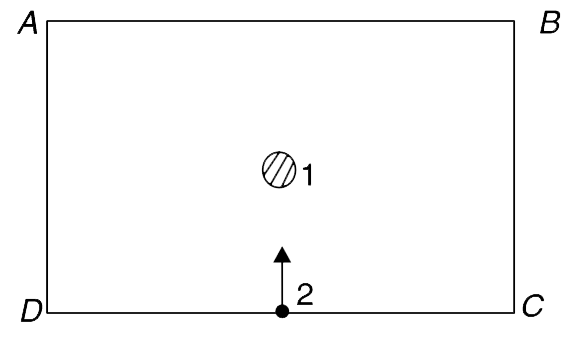A rectangular billiard table has dimensions AB=4√3 feet and BC=2 feet. Ball 1 is at the centre of the table. Ball 2 moving perpendicular to CD hits ball 1. After the collision ball 2 itself goes straight into the hole at. A Prove that ball 1 will fall into the hole at C. Assume that the balls are identical and their dimensions are too small compared to the dimensions of a hole. All collisions are elastic

Step by step video & image solution for A rectangular billiard table has dimensions AB = 4 sqrt(3) feet and BC = 2 feet. Ball 1 is at the centre of the table. Ball 2 moving perpendicular to CD hits ball 1. After the collision ball 2 itself goes straight into the hole at. A Prove that ball 1 will fall into the hole at C. Assume that the balls are identical and their dimensions are too small compared to the dimensions of a hole. All collisions are elastic by Physics experts to help you in doubts & scoring excellent marks in Class 11 exams.
Updated on:21/07/2023Topper's Solved these Questions
Similar Questions
Prove that in a two dimensional elastic collision of a moving ball with another stationary identical ball, the two balls move perpendicular to each other after collision?
View SolutionA ball X of mass 1 kg travellingg at 2 m/s has a head-on collision with an identical ball Y at rest. X stops and Y moves off. Calculate the velocity of Y after the collision.
View Solution
Knowledge Check
Select the alternative which best expresses the meaning of the Idiom/Phrase
Tit for tatAEquivalent retaliationBMiss something of what is going on aroundCEnable someone to avoid humiliationDTo be in the best position to do somethingA ball moving with a velocity of 6 m/s strikes an identical stationary ball. After collision each ball moves at angle of 30∘ with the original line of motion. Assuming that the collision is elastic, what are the speeds of the balls after the collision?
A√32m/s,2√3m/sB3m/s,2√3m/sC2√3m/s,2√3m/sD√3ms,√3m/sTwo billiard balls undergo a head-on collision. Ball 1 is twice as heavy as ball 2. Initially, ball 1 moves with a speed v towards ball 2 which is at rest. Immediately after the collision, ball 1 travels at a speed of v/3 in the same direction. What type of collision has occured?
AinelasticBelaticCcompletely inelasticDCannot be determined from the information
Two billiard balls undergo a head-on collision. Ball 1 is twice as heavy as ball 2. Initially, ball 1 moves with a speed v towards ball 2 which is at rest. Immediately after the collision, ball 1 travels at a speed of v/3 in the same direction. What type of collision has occured ?
View SolutionTwo billiard balls undergo a head-on collision. Ball 1 is twice as heavy as ball 2. Initially, ball 1 moves with a speed v towards ball 2 which is at rest. Immediately after the collision, ball 1 travels at a speed of v/3 in the same direction. What type of collision has occured ?
View SolutionA heavy ball moving with speed v collides with a tiny ball. The collision is elastic, then immediately after the impact, the second ball will move with a speed approximately equal to
View SolutionA ball moving with speed v hits another identical ball at rest. The two balls stick together after collision. If specific heat of the material of the balls is S , the temperature rise resulting from the collision is
View SolutionA ball moving with speed v hits another identical ball at rest. The two balls stick together after collision. If specific heat of the material of the balls is S , the temperature rise resulting from the collision is
View Solution
